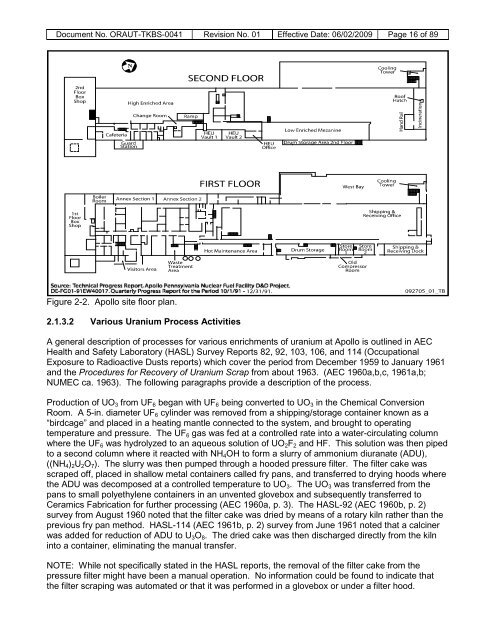ORAU TEAM Dose Reconstruction Project for NIOSH
ORAU TEAM Dose Reconstruction Project for NIOSH
ORAU TEAM Dose Reconstruction Project for NIOSH
You also want an ePaper? Increase the reach of your titles
YUMPU automatically turns print PDFs into web optimized ePapers that Google loves.
Document No. <strong>ORAU</strong>T-TKBS-0041 Revision No. 01 Effective Date: 06/02/2009 Page 16 of 89<br />
Figure 2-2. Apollo site floor plan.<br />
2.1.3.2 Various Uranium Process Activities<br />
A general description of processes <strong>for</strong> various enrichments of uranium at Apollo is outlined in AEC<br />
Health and Safety Laboratory (HASL) Survey Reports 82, 92, 103, 106, and 114 (Occupational<br />
Exposure to Radioactive Dusts reports) which cover the period from December 1959 to January 1961<br />
and the Procedures <strong>for</strong> Recovery of Uranium Scrap from about 1963. (AEC 1960a,b,c, 1961a,b;<br />
NUMEC ca. 1963). The following paragraphs provide a description of the process.<br />
Production of UO3 from UF6 began with UF6 being converted to UO3 in the Chemical Conversion<br />
Room. A 5-in. diameter UF6 cylinder was removed from a shipping/storage container known as a<br />
“birdcage” and placed in a heating mantle connected to the system, and brought to operating<br />
temperature and pressure. The UF6 gas was fed at a controlled rate into a water-circulating column<br />
where the UF6 was hydrolyzed to an aqueous solution of UO2F2 and HF. This solution was then piped<br />
to a second column where it reacted with NH4OH to <strong>for</strong>m a slurry of ammonium diuranate (ADU),<br />
((NH4)2U2O7). The slurry was then pumped through a hooded pressure filter. The filter cake was<br />
scraped off, placed in shallow metal containers called fry pans, and transferred to drying hoods where<br />
the ADU was decomposed at a controlled temperature to UO3. The UO3 was transferred from the<br />
pans to small polyethylene containers in an unvented glovebox and subsequently transferred to<br />
Ceramics Fabrication <strong>for</strong> further processing (AEC 1960a, p. 3). The HASL-92 (AEC 1960b, p. 2)<br />
survey from August 1960 noted that the filter cake was dried by means of a rotary kiln rather than the<br />
previous fry pan method. HASL-114 (AEC 1961b, p. 2) survey from June 1961 noted that a calciner<br />
was added <strong>for</strong> reduction of ADU to U3O8. The dried cake was then discharged directly from the kiln<br />
into a container, eliminating the manual transfer.<br />
NOTE: While not specifically stated in the HASL reports, the removal of the filter cake from the<br />
pressure filter might have been a manual operation. No in<strong>for</strong>mation could be found to indicate that<br />
the filter scraping was automated or that it was per<strong>for</strong>med in a glovebox or under a filter hood.

















